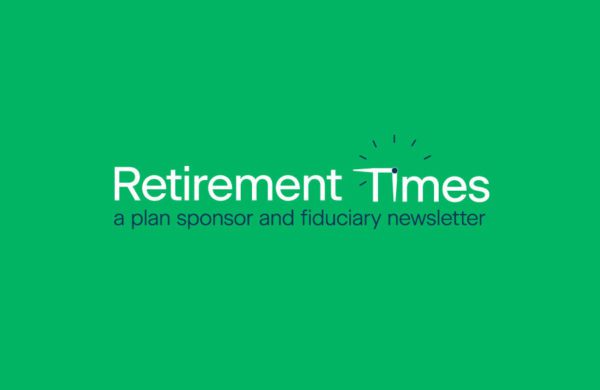When does a participant loan become a deemed distribution?
A recent IRS Issue Snapshot (link below) affirms that a participant loan is a legally enforceable agreement, and terms of the loan agreement must comply with Internal Revenue Code (IRC Section 72(p)(2) and Treasury Regulation Section 1.72(p)-1). The terms of the loan agreement must be explicit in writing or deliverable electronically.
A loan in default is considered to be a deemed distribution. But plans may offer a cure period during the quarter following the quarter in which the missed loan repayment occurred.
A deemed distribution can occur at the date the loan is made if:
- Participant loans exceed the maximum dollar amount of $50,000;
- Payment schedules do not comport with time or payment amortization requirements; or
- The loan agreement is either not legally enforceable or does not exist.
If any of the above requirements are not met, the loan would be determined to be in default and will be considered a deemed distribution.
A deemed distribution is accompanied by immediate tax consequences to the participant.
The complete IRS Issue Snapshot is at www.irs.gov/retirement-plans/deemed-distributions-participant-loans
Financial Wellness Needs a Long and Short Game to Work for Both Participants and Organizations
In the retirement plan industry, all too often we tend to conflate financial wellness with retirement readiness — whether that means confidence in obtaining retirement goals or being on track to reach post-employment financial targets. However, that limited view may fail to paint a complete picture for many participants.
For example, the New York Life Wealth Watch survey, released in July, highlights generational differences with respect to near- and long-term financial concerns and points to areas of disconnect among respondents’ financial self-assessments. Millennials (45 percent) report more confidence than both Gen X (35 percent) and Gen Z (33 percent) that their retirement savings will last the rest of their lives and express greater confidence than Gen Xers in their ability to retire when they want.
At the same time, Millennials indicate lower levels of confidence in their post-pandemic finances, with nearly one-third predicting that resuming pre-pandemic spending would have a negative impact on their household budget. Additionally, only 41 percent report feeling confident about their ability to make a down payment on a home. While emerging COVID-19 variants call into question the timing of “post-pandemic” assessments in general, these findings highlight the need for broad-based financial wellness assessments and programming nonetheless.
Near-term financial concerns are likely contributors to employee stress and can weigh on productivity. In fact, 42 percent of full-time employees find it difficult to meet monthly household expenses, according to PwC’s 2021 Employee Financial Wellness Survey. Student loans, housing expenses, food costs and health insurance rates contribute to employee insecurity, and more employees have considered filing for bankruptcy protection than ever before in the survey’s decade-long history. If organizations fail to address worker financial wellness, PwC says, the additional psychological stress will likely continue to impact productivity and employee well-being.
Ideally, financial wellness should comprise a comprehensive and wholistic approach that’s easy for companies to implement, provides targeted interventions — and taps both long- and short-term financial concerns. Moreover, your financial wellness program should offer proactive employee engagement with online education, group content and individual sessions. This is critical because it can be difficult for participants to focus on achieving long-term financial objectives when they have more immediate unmet needs and concerns, such as being unprepared for financial emergencies or managing crippling levels of personal debt.
With pandemic uncertainties lingering a year and a half into the global crisis, financial wellness has become more important than ever. Retirement-focused education and programming is necessary, but not sufficient to meet all participants’ and employers’ needs in an increasingly complex world. Be sure your financial wellness program can help your employees and organization plan and prepare for today and tomorrow.
Sources
https://www.newyorklife.com/newsroom/2021/wealth-watch-covid-financial-confidence
https://www.pwc.com/us/en/services/consulting/workforce-of-the-future/library/employee-financial-wellness-survey.html
The auditors are coming — Are you ready?
No one wants to be caught flat-footed when the auditors come calling. And with a new standard issued by the American Institute of Certified Public Accountants (AICPA), both the auditors and plan sponsors will be subject to new responsibilities.
The AICPA’s Statement on Auditing Standards (SAS) No. 136, Forming an Opinion and Reporting on Financial Statements of Employee Benefit Plans Subject to ERISA, raises the bar on benefit plan audits. Issued in 2019, the standard was originally scheduled to go into effect in 2020 but was delayed due to the pandemic. It is now effective for audits of ERISA plan financial statements for periods ending on or after Dec. 15, 2021.
SAS 136 impacts all ERISA plan audit phases and makes significant changes to the content of audit reports in an effort to promote greater transparency. But in addition to the impact on accounting professionals who conduct the audit, the new standard introduces new requirements for plan sponsors. For example, when receiving a “limited scope audit” — a term the new standard replaces with “ERISA Section 103(a)(3)(C) audit” — auditors will no longer issue a disclaimer of opinion and will instead provide an audit report. But before the auditor can accept the audit, the plan sponsor must indicate in writing that he or she permits the engagement and that it will meet ERISA requirements.
Plan sponsors are also now required to acknowledge responsibility for administering the plan in the audit engagement letter. What’s more, at the end of the audit, they need to acknowledge additional responsibilities, such as maintaining a copy of the plan document, ensuring transactions conform to the plan’s provisions and maintaining sufficient participant records to determine benefits due to them.
Further changes in the standard come from new provisions regarding completion of Form 5500. Before the audit engagement, plan sponsors will need to provide the auditor with a substantially completed copy of the form, as well as its schedules. The auditor will then compare the form against the financial statements to determine if there are any material discrepancies and indicate whether either the form or the statements require any corrections.
Compliance with SAS 136 will result in a much more thorough audit and a more revealing report on the organization’s compliance with ERISA requirements. With that in mind, plan sponsors should note the potential for additional exposure to legal risk. According to ERISA expert Timothy Verrall in a recent PlanSponsor.com article, the audit report, which may disclose noncompliance issues, is attached to Form 5500 and then becomes publicly available.
“Anyone can look at it,” Verrall says in the article. “One way lawsuits get started is people doing searches on Form 5500 data filings. This could potentially provide a new source of ammunition to plaintiffs’ lawyers.”
“That said, from a pragmatic perspective most issues reported in annual auditors reports are of a limited, and even individual, nature,” says Joel Shapiro, SVP ERISA of NFP, “and they are often immediately remedied, thereby leaving little real ‘meat on the bone’ for class action plaintiffs attorneys as the result.”
With so much change being introduced, sponsors will want to ensure they’re adequately prepared to meet the new requirements and thoroughly understand their responsibilities. That way, when the auditors come knocking, you won’t be caught unawares. To see the full AICPA revision, download SAS 136 from the institute’s website (PDF).
Sources
https://www.plansponsor.com/in-depth/new-financial-audit-rule-increases-requirements-plan-sponsors/
https://www.eisneramper.com/employee-benefit-plan-audit-standards-sas-136-0621/
https://www.shrm.org/resourcesandtools/hr-topics/benefits/pages/new-audit-standard-affects-employee-benefits-plan-sponsors.aspx
https://us.aicpa.org/content/dam/aicpa/research/standards/auditattest/downloadabledocuments/sas-136.pdf
Securities offered through Kestra Investment Services, LLC (Kestra IS), member FINRA/SIPC. Investment advisory services offered through Kestra Advisory Services, LLC (Kestra AS) an affiliate of Kestra IS. Kestra IS and Kestra AS are not affiliated with Higginbotham.
The “Retirement Times” is published monthly by Retirement Plan Advisory Group’s marketing team. This material is intended for informational purposes only and should not be construed as legal advice and is not intended to replace the advice of a qualified attorney, tax adviser, investment professional or insurance agent. (c) 2018. Retirement Plan Advisory Group.


